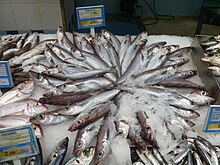| Blue whiting | |
|---|---|

| |
| Scientific classification | |
| Domain: | Eukaryota |
| Kingdom: | Animalia |
| Phylum: | Chordata |
| Class: | Actinopterygii |
| Order: | Gadiformes |
| Family: | Gadidae |
| Genus: | Micromesistius |
| Species: | M. poutassou |
| Binomial name | |
| Micromesistius poutassou (A. Risso, 1827) | |

| |
| Range of blue whiting | |
| Synonyms | |
The blue whiting (Micromesistius poutassou) one of the two species in the genus Micromesistius in the family Gadidae, which also contains cod, haddock, whiting, and pollock. It is common in the northeast Atlantic Ocean from Morocco to Iceland and Spitsbergen. It also occurs in the northern parts of the Mediterranean, where it may be locally abundant. Blue whiting also occur in the northwest Atlantic Ocean between Canada and Greenland, but is considered rare. It has a long, narrow body and a silvery underbody. The fish can attain a length of more than 40 cm. The average length of blue whiting caught off the west shores of the UK is 31 cm.
A related species, southern blue whiting, Micromesistius australis, occurs in the Southern Hemisphere.
Fisheries
Exploitation of blue whiting only started in the 1970s. The species, in the last decades, has become increasingly important to the fishing industries of northern European countries, including Russia. Catches exceeded 1 million tonnes from 1998 to 2008. According to the Food and Agriculture Organization of the United Nations, blue whiting was fifth most important capture fish species in 2006. However, recruitment of the stock fell to a low level in 2006 and has been weak ever since, causing declining spawning stock and eventually triggering strong reductions in catch quotas. The reasons for low recruitment in recent years are poorly known. The total quota for 2011 was set to 40,100 tonnes, which is less than 2% of the record catch of 2.4 million tonnes in 2004. Catches in 2011 exceeded the quota by more than 100%.
For 2012, ICES advised the catches should be no more than 391,000 tonnes (385,000 long tons; 431,000 short tons). This large increase relative to the quota in 2011 (but not to the catches in 1998–2008) is caused by a revision in the stock assessment; however, recruitment to the stock is still low and the stock is forecasted to decline. The coastal states set the total quota for 2012 to 391,000 tonnes.
The fish is usually not marketed fresh, but processed into fish meal and oil. However, in Russia, southern Europe, and Japan, blue whiting are sometimes sold as food fish.

Management

Blue whiting in the northeast Atlantic is a straddling stock: it occupies the exclusive economic zone (EEZ) of the Faroe Islands, the European Union, Iceland and Norway, as well as the high seas". This means effective regulation calls for international co-operation.
Quota advice for blue whiting in the northeast Atlantic is provided by ICES. For a long period, blue whiting fisheries were mainly regulated through nationally set quotas because there was no international agreement about sharing the total quota; consequently, the total catch greatly exceeded the advised quotas However, the Coastal States (the Faroe Islands, the European Union, Iceland and Norway) reached an agreement in December 2005, ending the period of what was sometimes referred to as "Olympic fishing". Since 2006, the blue whiting fishery has been regulated under this agreement, which gives the greatest share to the European Union, but through quota swaps, Norway has been holding the largest annual quotas.

References
- Bailey, R. S. (1982). "The population biology of blue whiting in the North Atlantic". Advances in Marine Biology. 19: 257–355. doi:10.1016/S0065-2881(08)60089-9. ISBN 9780120261192.
- "Handling and Processing Blue Whiting". Archived from the original on 2010-05-01. Retrieved 2008-04-06.
- ^ ICES Advice 2010: Blue whiting in Subareas I–IX, XII, and XIV (Combined stock) Archived August 12, 2011, at the Wayback Machine
- The State of World Fisheries and Aquaculture 2008
- Payne, M. R.; Egan, A.; Fässler, S. M. M.; Hátún, H. L.; Holst, J. C.; Jacobsen, J. A.; Slotte, A.; Loeng, H. (2012). "The rise and fall of the NE Atlantic blue whiting (Micromesistius poutassou)" (PDF). Marine Biology Research. 8 (5–6): 475–487. doi:10.1080/17451000.2011.639778. hdl:10379/13432. S2CID 59376591.
- Agreed Record of Conclusions of Fisheries Consultations between the Faroe Islands, the European Union, Iceland and Norway on the Management of Blue Whiting in the North-East Atlantic in 2011
- Final Catch figures Blue whiting 2011
- ICES Advice September 2011. Blue whiting in Subareas I–IX, XII, and XIV (Combined stock) Archived April 2, 2012, at the Wayback Machine
- Agreed Record of Conclusions of Fisheries Consultations Between Iceland, the European Union, the Faroe Islands and Norway on the Management of Blue Whiting in the North-East Atlantic in 2012
- "Fisheries and Aquaculture - Global Production". Food and Agriculture Organization of the United Nations (FAO). Retrieved 2024-05-06.
- "Straddling stocks". Archived from the original on 2015-06-03. Retrieved 2011-08-20.
- Standal, D. (2006). "The rise and decline of blue whiting fisheries—capacity expansion and future regulations". Marine Policy. 30 (4): 315–327. doi:10.1016/j.marpol.2005.03.007.
- Press release: Broad agreement on fisheries between Norway and the EU
External links
- FishBase
- Blue whiting: playing a big game with small fish
- Northeast Atlantic blue whiting. Chapter 11 in Life-cycle spatial patterns of small pelagic fish in the Northeast Atlantic. ICES Cooperative Research Report 306, 2010
- The Marine Flora and Fauna of Norway: Blue whiting (with photographs of living blue whiting!)